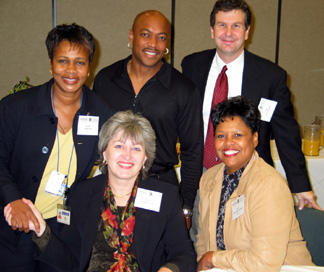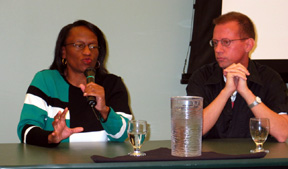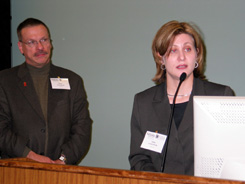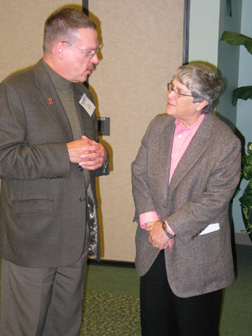 |
Seated, left, Susan Swindells, MBBS, and Valda Boyd Ford, director, UNMC Community and Multicultural Affairs. Standing from left, Sherri Nared, Kevin Ballew, HIV prevention specialist, Douglas County Health Department, and Jack Stapleton, M.D. |
That is why, in 1998, UNMC’s HIV Clinic staff began its annual “Update for HIV Care Providers and Educators.” Participants from Nebraska and Iowa come to Omaha for the daylong seminar and leave with the most current information available. Speakers discuss cutting-edge drug therapies, new diagnostic testing procedures that provide results in minutes and vital new research results on the sociology and demographics of new infection rates. As the virus follows its own pathology of evolution and change, so does the entire network of response to what is now the world’s most deadly disease.
“The field of HIV medicine is rapid changing, with medical breakthroughs and changes in treatments and medications occurring very frequently,” said Joseph Hoagbin, M.D., medical director, Nebraska AIDS Education and Training Center, and assistant professor in UNMC’s Department of Internal Medicine-Infectious Diseases.
 |
Margie Dumas and Raymond Bordeaux, two people living with AIDS, share their stories. |
“HIV clinicians now have 20 different antiretroviral or ‘HIV drugs’ to care for patients. This allows the providers to tailor the medications to the needs of the individual patient in ways never before possible. Newer medications usually require fewer numbers of pills and reduced frequency of administration. Moreover, many of the newest medications have reduced toxicities. It is always our goal to prescribe the simplest, yet most potent, regimen possible that is most appropriate for the patient’s medical condition, thereby encouraging adherence, reducing drug side effects and improving outcomes.”
The HIV Update has evolved into an all-day meeting, drawing people from Omaha, out state Nebraska and western Iowa. The attendees are physicians, nurses, physician assistants, nurse practitioners, dentists, dental hygienists, mental health professionals, case managers and community members. Every seminar, using the faculty and staff from UNMC and invited distinguished faculty from other educational institutions, offers the most cutting-edge scientific research and educational information available. In previous years, most of the participants would have to travel significant distances to other parts of the country to attend seminars of this caliber.
 |
Edna Klingler, M.D., responds to questions after her presentation, as Joseph Hoagbin, M.D., looks on. |
Overall, AIDS cases have declined in Nebraska from 1995 to 2003 – from about 80 new cases per year to about 50, Jackson said. But 60 percent of all Nebraska cases are from Douglas County and although African Americans are only 4 percent of the state’s population, they now account for 29 percent of new infections.
“HIV is clearly disproportionately affecting African Americans,” Jackson said. “The state
has resource funding available for education and prevention, but we need many more black agencies to apply for these resources and expand the war against HIV infection in the African American community.”
Sherri Nared, HIV prevention specialist, Douglas County Health Department, discussed HIV prevention in teenagers – the fastest growing demographic today for new infection rates.
 |
Joseph Hoagbin, M.D., chats with Kristin Ries, M.D., before her presentation. |
“Everything changes in our business except our mission,” said Susan Swindells, MBBS, Terry Watanabe Professor of Medicine and medical director, UNMC HIV Clinic.
“We must create more effective prevention and education techniques that will keep people from ever needing our clinic in the first place,” she said, during her discussion on “Friendly Fire: HIV, Drugs and Complications. “Short of that, we need to get the message more deeply rooted in the community that AIDS is no longer a death sentence. With timely testing for the virus and early diagnosis, we now have the clinical tools and access to the social resources that can help people live productive lives for many years to come.”
Among the day’s presenters, Edna Klingler, M.D., assistant professor, UNMC Department of Internal Medicine-Infectious Diseases, spoke on “Another Look at HIV in Women.” Harry Naasz, case manager in UNMC HIV Clinic, hosted a panel discussion that featured three people from different communities who are living with AIDS.
During the afternoon sessions, Jack Stapleton, M.D., professor and interim director, University of Iowa division of infectious diseases, spoke on “Liver Spot: Hepatitis G.” James Sorrell, M.D., assistant professor, UNMC Department of Psychiatry, discussed “Addiction and the HIV/AIDS Patient.” Kristin Ries, M.D., professor, University of Utah School of Medicine, focused on “Enhancing Adherence.”